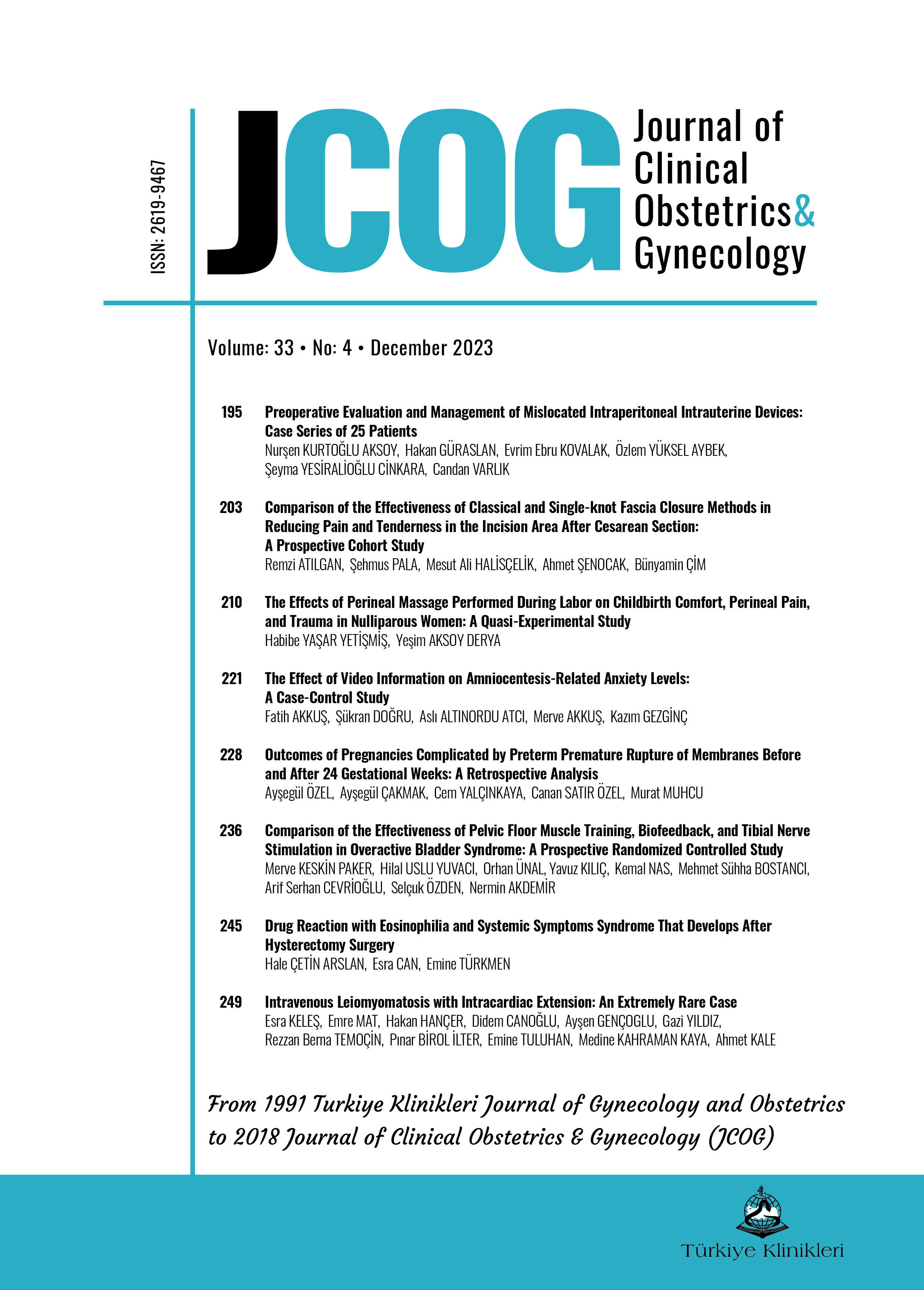Open Access
Peer Reviewed
ORIGINAL RESEARCH
761 Viewed982 Downloaded
Preoperative Evaluation and Management of Mislocated Intraperitoneal Intrauterine Devices: Case Series of 25 Patients
Received: 28 Mar 2023 | Accepted: 01 Sep 2023 | Available online: 12 Sep 2023
JCOG. 2023;33(4):195-202
DOI: 10.5336/jcog.2023-97045
Article Language: EN
Article Language: EN
Copyright Ⓒ 2020 by Türkiye Klinikleri. This is an open access article under the CC BY-NC-ND license (http://creativecommons.org/licenses/by-nc-nd/4.0/)
ABSTRACT
Objective: The aim of this study is to document the preoperative evaluation techniques of mislocated intrauterine device (IUD) patients and discuss the optimal management of these cases. Material and Methods: This study was conducted between January 2016 and October 2021 at an obstetrics and gynecology department of a tertiary center. A total of 25 patients presenting with mislocated IUDs were retrospectively analyzed. Demographic findings, diagnostic and preoperative evaluation methods, and operation notes were collected from the patients' files and hospital patient information programs. Results: Every patient had initially undergone a preoperative gynecologic examination and transvaginal ultrasonography (TVUSG). After TVUSG, other preoperative techniques were used alone or in combination according to each finding and need of further technique. Plain radiography, hysteroscopy, computed tomography (CT), magnetic resonance imaging (MRI), and colonoscopy were the techniques used. Of the 25 patients with missing IUDs, it was observed that 23 had successful removal of their IUDs. All but two of the patients were operated on laparoscopically. Conclusion: In cases of mislocated IUDs, all patients should undergo a vaginal examination and TVUSG. Although ultrasonography and radiography are the basic diagnostic techniques; radiography, hysteroscopy, CT, MRI, and colonoscopy are the techniques that can be used according to each case's condition. For these patients, laparoscopy was the first line of therapy.
Objective: The aim of this study is to document the preoperative evaluation techniques of mislocated intrauterine device (IUD) patients and discuss the optimal management of these cases. Material and Methods: This study was conducted between January 2016 and October 2021 at an obstetrics and gynecology department of a tertiary center. A total of 25 patients presenting with mislocated IUDs were retrospectively analyzed. Demographic findings, diagnostic and preoperative evaluation methods, and operation notes were collected from the patients' files and hospital patient information programs. Results: Every patient had initially undergone a preoperative gynecologic examination and transvaginal ultrasonography (TVUSG). After TVUSG, other preoperative techniques were used alone or in combination according to each finding and need of further technique. Plain radiography, hysteroscopy, computed tomography (CT), magnetic resonance imaging (MRI), and colonoscopy were the techniques used. Of the 25 patients with missing IUDs, it was observed that 23 had successful removal of their IUDs. All but two of the patients were operated on laparoscopically. Conclusion: In cases of mislocated IUDs, all patients should undergo a vaginal examination and TVUSG. Although ultrasonography and radiography are the basic diagnostic techniques; radiography, hysteroscopy, CT, MRI, and colonoscopy are the techniques that can be used according to each case's condition. For these patients, laparoscopy was the first line of therapy.
REFERENCES:
- Buhling KJ, Zite NB, Lotke P, Black K; INTRA Writing Group. Worldwide use of intrauterine contraception: a review. Contraception. 2014;89(3):162-73. [Crossref] [PubMed]
- Heinemann K, Reed S, Moehner S, Minh TD. Risk of uterine perforation with levonorgestrel-releasing and copper intrauterine devices in the European Active Surveillance Study on Intrauterine Devices. Contraception. 2015;91(4):274-9. [Crossref] [PubMed]
- Aydogdu O, Pulat H. Asymptomatic far-migration of an intrauterine device into the abdominal cavity: a rare entity. Can Urol Assoc J. 2012;6(3):E134-6. [Crossref] [PubMed] [PMC]
- Aliukonis V, Lasinskas M, Pilvelis A, Gradauskas A. Intrauterine device migration into the lumen of large bowel: a case report. Int J Surg Case Rep. 2020;72:306-8. [Crossref] [PubMed] [PMC]
- Markovitch O, Klein Z, Gidoni Y, Holzinger M, Beyth Y. Extrauterine mislocated IUD: is surgical removal mandatory? Contraception. 2002;66(2):105-8. [Crossref] [PubMed]
- Mechanism of action, safety and efficacy of intrauterine devices. Report of a WHO Scientific Group. World Health Organ Tech Rep Ser. 1987;753:1-91. [PubMed]
- Tabatabaei F, Masoumzadeh M. Dislocated intrauterine devices: clinical presentations, diagnosis and management. Eur J Contracept Reprod Health Care. 2021;26(2):160-6. [Crossref] [PubMed]
- Gill RS, Mok D, Hudson M, Shi X, Birch DW, Karmali S. Laparoscopic removal of an intra-abdominal intrauterine device: case and systematic review. Contraception. 2012;85(1):15-8. [Crossref] [PubMed]
- Adiyeke M, Sanci M, Karaca I, Gökçü M, Töz E, Ocal E. Surgical management of intrauterine devices migrated towards intra-abdominal structures: 20-year experience of a tertiary center. Clin Exp Obstet Gynecol. 2015;42(3):358-60. [Crossref] [PubMed]
- Atkinson AL, Baum JD. Missing IUD despite threads at the cervix. Case Rep Obstet Gynecol. 2014;2014:916143. [Crossref] [PubMed] [PMC]
- Moschos E, Twickler DM. Does the type of intrauterine device affect conspicuity on 2D and 3D ultrasound? AJR Am J Roentgenol. 2011;196(6):1439-43. [Crossref] [PubMed]
- Kaplanoğlu M, Bülbül M, Yüce T, Kaplanoğlu D, Aban M. Mislocated extrauterine intrauterine devices: diagnosis and surgical management. J Turk Ger Gynecol Assoc. 2015;16(2):91-5. [Crossref] [PubMed] [PMC]
- Kho KA, Chamsy DJ. Perforated intraperitoneal intrauterine contraceptive devices: diagnosis, management, and clinical outcomes. J Minim Invasive Gynecol. 2014;21(4):596-601. [Crossref] [PubMed] [PMC]
- Boortz HE, Margolis DJ, Ragavendra N, Patel MK, Kadell BM. Migration of intrauterine devices: radiologic findings and implications for patient care. Radiographics. 2012;32(2):335-52. [Crossref] [PubMed]
- Park JM, Lee CS, Kim MS, Kim DY, Kim CY, Lim YB, et al. Penetration of the descending colon by a migrating intrauterine contraceptive device. J Korean Soc Coloproctol. 2010;26(6):433-6. [Crossref] [PubMed] [PMC]
- Lu S, Yao X, Shi J, Huang J, Zhuang S, Ma J, et al. Is it a "colon perforation"? A case report and review of the literature. Front Med (Lausanne). 2022;9:817029. [Crossref] [PubMed] [PMC]
MENU
POPULAR ARTICLES
MOST DOWNLOADED ARTICLES





This journal is licensed under a Creative Commons Attribution-NonCommercial-NoDerivatives 4.0 International License.











